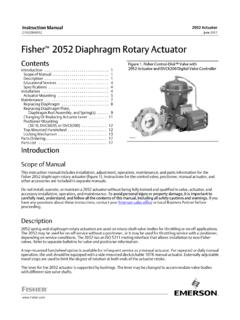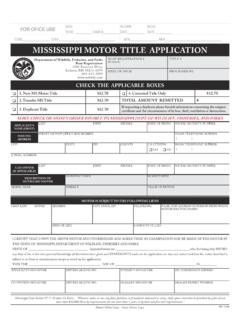Transcription of By John Kretschmer Irwin 52
1 By john KretschmerUSED BOAT NOTEBOOKThe boat that started the big boat deck-saloon revolutionIrwin 5238 SAILING JANUARY 2006his company garnered a reputa-tion for producing cheap boats. Ask sailors who came of age in the 1970s and 1980s what they think of Irwins and they ll likely scowl. However, time has shown that some complaints about Irwin s quality have turned out to be spurious. Older Irwins, espe-cially the larger models, are in high demand on the used mar-ket. If you can find a Series II 52 for a good price, even after totally refitting the boat, you ll make money, said Gene Gammons.
2 Gammons knows of what he speaks. These days he is a yacht broker but previously he was the project manager for the Irwin 52 and his Web site, , provides a wealth of information about all Irwin models. He worked side-by-side with Irwin for years. Launched in 1976, the Irwin 52 caught the sailing world off guard, suddenly it was possible to own your own small ship. While many 52s were employed as crewed charter boats there is no denying that privately owned models started the shift toward larger cruising boats.
3 First impressions The Irwin 52 has plenty of freeboard and a moderate sheer accentuated by a rakish bowsprit. The raised aft deck irked purists, who still existed in the 1970s, but provided plenty of headroom for the luxurious aft cabin, and along with the wide cove stripe, became something of a 52 trademark. It does take some getting used to when navigating the big step on deck, especially in the dark with lumpy seas. The cabintrunk includes large side and forward facing ports that flood the inte-rior with light. I remem-ber the dire warnings we experts issued about tak-ing big windows off-shore.
4 Today most sailors can t get enough of the deck-saloon concept. Although Irwin knew that he had to build cruis-ing boats if he wanted to stay in business, his The Irwin 52 was a trend-setting boat. It was a deck-saloon cruiser before there were deck-saloon cruisers. What s more, the Irwin 52, with more than 250 hulls launched, may be the most popular big boat, 50-foot-plus, ever built. These beamy ketch-rigged cruisers offered no apologies for their motoryacht-like interior accommodations, spacious cockpit, wide side decks and raised bulwarks.
5 It boasts of good performance under power as well as sail. Hmm, come to think of it those features sound awfully familiar? When you take a look at many of today s larger cruising boats, it seems that Ted Irwin was a visionary. Ironically, the Irwin 52 has a better reputation today, 30 years after it was first introduced, than it did when new. Ted Irwin was an enigma in the industry. He was a designer, builder and world-class sailor, and during the early 1980s, his company was the largest pri-vately owned sailboat firm in the country.
6 He sold a lot of boats, especially big boats. Irwin claims to have built more sailboats lon-ger than 50 feet than anyone in the world. Still, despite his consistently innovative designs, heart was always in performance boats. The 52 sports a generous rig with more than 1,350 square feet of working sailing area. The underbody is refined with a cut-away long keel and a partially balanced rudder. The 52 moves under sail. Indeed, with its long 44-foot waterline it reaches along at 8 knots steadily. I have logged a lot of miles delivering 52s and I am always impressed with how well they sail.
7 Although it is not particularly close winded, the Irwin 52 is a much better performer than other big cruising designs of the period, including the clipper bow designs of Bill Garden and blunt bowed Out Island series by Charlie Morgan. Most 52s were centerboards with a board-up draft of 5 feet, 6 inches. The original air draft of 67 feet made the Intracoastal a no-fly zone, although you may well find the boat you re consid-ering has had the rig shortened to less than 65 feet. Construction The bugaboo with Irwin Yachts is just how well built were they?
8 While some of the smaller mod-els have not held up well over the years, the bigger boats, built to heavier scantlings, have endured the ravishes of ocean and owner-ship pretty well. The construc-tion of the 52 evolved over the years. Early boats had solid glass hulls while later boats, after the Series II was introduced in 1982, had Klegecell coring from the waterline up. All models featured plywood cored decks. And while plywood is not the best mate-rial for this purpose because it is heavy and prone to rot, Irwin mitigated the latter issue at least by using four-inch squares satu-rated with resin.
9 The box joint of the hull and deck includes the wide bulwark and a handsome teak caprail. Early models were classic pro-duction boats using three massive interior pans. These molded units were tabbed to the hull. As with any large secondary bonding, there is the potential for prob-lems, and it limits access to the hull. Also, these pans restricted the interior options the layout was the layout and you either took it or left it. The Series II boats featured all wood interior construction with bulkheads and facings fiberglassed directly to the hull, which allowed custom-ized plans.
10 What to look for The key to making a smart purchase of an Irwin 52 is to know just what model you re looking at. Series II boats, which were substantially upgraded and are easier to retrofit, were intro-duced in 1982. This is not always reflected in the price of used 52s. It seems as if owners and brokers just look at other boats on the market and price theirs accordingly. This can work to the advantage of the savvy shopper. Also, don t confuse the 52 with the 54, which is quite easy to do because they are basically the same boat.









